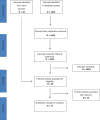ABPI reporting and compression recommendations in global clinical practice guidelines on venous leg ulcer management: A scoping review
- PMID: 30485668
- PMCID: PMC7949354
- DOI: 10.1111/iwj.13048
ABPI reporting and compression recommendations in global clinical practice guidelines on venous leg ulcer management: A scoping review
Erratum in
-
Corrigendum.Int Wound J. 2019 Aug;16(4):1074. doi: 10.1111/iwj.13165. Epub 2019 Jul 11. Int Wound J. 2019. PMID: 31328899 Free PMC article. No abstract available.
Abstract
Clinical practice guidelines (CPGs) for venous leg ulcer (VLU) management recommend below-knee compression to improve healing outcomes after calculating the ankle-brachial pressure index (ABPI) to rule out significant arterial disease. This systematic scoping review aimed to complete a qualitative and quantitative content analysis of international CPGs for VLU management to determine if consensus existed in relation to recommendations for compression application based on an ABPI reading and clinical assessment. Our review shows that there is a lack of consensus across 13 VLU CPGs and a lack of clear guidance in relation to the specific ABPI range of compression therapy that can be safely applied. An area of uncertainty and disagreement exists in relation to an ABPI between 0.6 and 0.8, with some guidelines advocating that compression is contraindicated and others that there should be reduced compression. This has implications in clinical practice, including when it is safe to apply compression. In addition, the inconsistency in the levels of evidence and the grades of recommendation makes it difficult to compare across various guidelines.
Keywords: ankle-brachial pressure index (ABPI); clinical practice guidelines; consistency; scoping review; venous leg ulcers.
© 2018 Medicalhelplines.com Inc and John Wiley & Sons Ltd.
Conflict of interest statement
All persons designated as authors qualify for authorship. Each author has participated sufficiently in the work to take public responsibility for the content.
Similar articles
-
Initial management of leg ulcers in community settings: proposals for a new algorithm for general practitioners.J Wound Care. 2025 Jun 2;34(6):389-396. doi: 10.12968/jowc.2025.0142. Epub 2025 May 27. J Wound Care. 2025. PMID: 40504400
-
Compression therapy for venous leg ulcers: risk factors for adverse events and complications, contraindications - a review of present guidelines.J Eur Acad Dermatol Venereol. 2017 Sep;31(9):1562-1568. doi: 10.1111/jdv.14390. Epub 2017 Jul 31. J Eur Acad Dermatol Venereol. 2017. PMID: 28602045 Review.
-
Recalcitrant Venous Leg Ulcers May Heal by Outpatient Treatment of Venous Disease Even in the Presence of Concomitant Arterial Occlusive Disease.Eur J Vasc Endovasc Surg. 2016 Sep;52(3):385-91. doi: 10.1016/j.ejvs.2016.06.004. Epub 2016 Jul 28. Eur J Vasc Endovasc Surg. 2016. PMID: 27476154
-
A Meta-analysis to Compare Four-layer to Short-stretch Compression Bandaging for Venous Leg Ulcer Healing.Ostomy Wound Manage. 2018 May;64(5):30-37. Ostomy Wound Manage. 2018. PMID: 29847309 Review.
-
Venous leg ulcer management in clinical practice in the UK: costs and outcomes.Int Wound J. 2018 Feb;15(1):29-37. doi: 10.1111/iwj.12814. Epub 2017 Dec 15. Int Wound J. 2018. PMID: 29243398 Free PMC article.
Cited by
-
Haemodynamic effect of a leg compression bandage on the distal posterior tibial artery using 4D flow magnetic resonance imaging: A quantitative study.Int Wound J. 2024 Jul;21(7):e14901. doi: 10.1111/iwj.14901. Int Wound J. 2024. PMID: 38937919 Free PMC article.
-
Understanding factors influencing venous leg ulcer guideline implementation in Australian primary care.Int Wound J. 2020 Jun;17(3):804-818. doi: 10.1111/iwj.13334. Epub 2020 Mar 9. Int Wound J. 2020. PMID: 32150790 Free PMC article.
-
Analysis of Risk Factors Responsible for Neuropathy in Patients with Type 2 Diabetes Mellitus with Diabetic Foot During the COVID-19 Pandemic.Iran J Nurs Midwifery Res. 2023 Jan 27;28(1):85-91. doi: 10.4103/ijnmr.ijnmr_180_21. eCollection 2023 Jan-Feb. Iran J Nurs Midwifery Res. 2023. PMID: 37250947 Free PMC article.
-
Patient Explanation of Adherence and Non-Adherence to Venous Leg Ulcer Treatment: A Qualitative Study.Front Pharmacol. 2021 Jun 3;12:663570. doi: 10.3389/fphar.2021.663570. eCollection 2021. Front Pharmacol. 2021. PMID: 34149416 Free PMC article.
-
Corrigendum.Int Wound J. 2019 Aug;16(4):1074. doi: 10.1111/iwj.13165. Epub 2019 Jul 11. Int Wound J. 2019. PMID: 31328899 Free PMC article. No abstract available.
References
-
- Franks PJ, Barker J, Collier M, et al. Management of patients with venous leg ulcers: challenges and current best practice. J Wound Care. 2016;25(Suppl 6):S1‐s67. - PubMed
-
- Weller CD, Evans S. Venous leg ulcer management in general practice. Practice nurses and evidence based guidelines. Aust Fam Physician. 2012;41(5):331‐337. - PubMed
-
- Weller CD, Ademi Z, Makarounas‐Kirchmann K, Stoelwinder J. Economic evaluation of compression therapy in venous leg ulcer randomised controlled trials: a systematic review. Wound Pract Res. 2012;20(1):21.
Publication types
MeSH terms
Grants and funding
LinkOut - more resources
Full Text Sources
Medical


